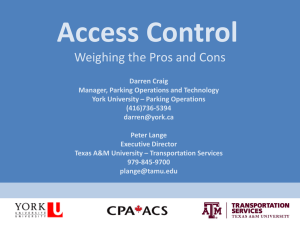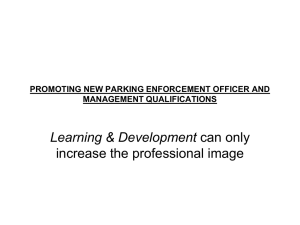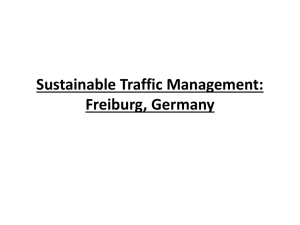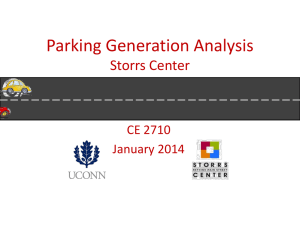Parking - Island Press
advertisement
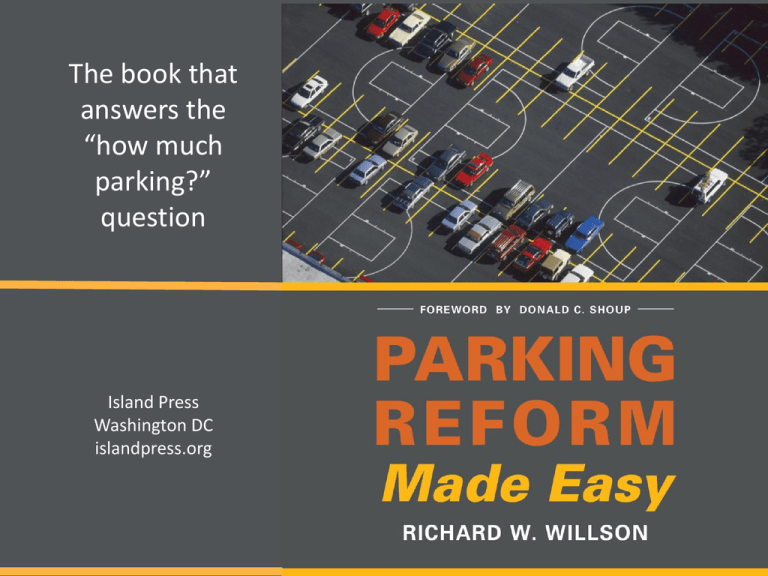
The book that answers the “how much parking?” question Island Press Washington DC islandpress.org The smoking gun… Parking requirements create one of the most wasteful elements of transportation and land use systems: unoccupied parking spaces. Did you know that there are over 3 spaces for each car in the U.S.? This is a view of a typical suburb. The dark gray areas are parking, much of which is unoccupied. Land uses are separated, with each one providing parking to meet its peak demand. This pattern of parking wastes land and favors automobile use. Alternative travel modes such as transit, walking, and cycling cannot compete. This is an on-the-ground view of the shopping mall in the previous slide. These spaces are occupied during the peak shopping season, but they sit empty the rest of the year. This image shows the fine-grained built form found in older neighborhoods. Off-street parking does not dominate the built form or street experience. There is a parking requirement problem here as well – excess requirements hamper revitalization and business creation by preventing new restaurants from locating in historic buildings. Storefronts, street trees, awnings, and on-street parking create a good pedestrian environment, but free on-street parking reduces shared use of off-street parking, justifying excessive parking requirements. The circle of vice Parking requirements shape land use patterns, transportation systems, and travel behavior. The next slide illustrates the consequences when minimum requirements exceed parking utilization. Parking is policy The process of establishing parking requirements is often perceived to be a technical matter. Rather, it is primarily a policy decision. The next slide shows that parking requirements are linked to four key community goals. Putting parking requirements in their place Parking requirements are but one way of ensuring accessibility. The next slide shows a range of planning strategies that provide access. When we start with parking requirements, we treat them as an end not a means. Said another way, it is a case of “the tail wagging the dog.” Habit, leverage, addiction, or what? Habit: “That’s the way we’ve always done it” Leverage: “Excessive parking requirements help me negotiate for other public benefits” Addiction: “My community needs plentiful and free parking” A twelve step program… The next slide shows twelve steps for reforming parking requirements. The process starts with local parking utilization data and makes a series of analytic and policy adjustments to account for future conditions, local plans, and policy decisions regarding parking supply. Requirement options…and developer responses The next slide shows different types of parking requirements, from traditional to deregulated. The right approach for your community depends on local conditions and policy choices. Approach Requirement Developer Response Minimum > utilization Traditional Rarely build more than requirement No maximum Moderate Minimum = utilization Assess market for project, may exceed reform No maximum minimum Big city Minimum = % of utilization Market decision whether to supply approach Maximum = ratio or % of minimum minimum or build to maximum Partial No minimum Market decision whether to supply parking deregulation Maximum = ratio or % of minimum or build to maximum No minimum or maximum; Deregulation Performance measures, e.g., traffic impacts Market decision on whether/how much Bells and whistles… Parking requirements deal with a lot more than minimum ratios. On the next slide, the list on the left shows ways of “taming” the negative impacts of parking; on the right side are examples of varied parking supply requirements. “Taming” Parking • • • • • • • • • • • Driveway regulations Prohibit surface Ground floor retail Height restrictions % of block facades for garage doors Discretionary design review Shading Permeable pavement Solar Real-time information Guidance systems Supply Regulations • • • • • • • • • • • • • • • Eliminate minimums Maximums Discretionary determination Tandem Re-use projects Overlays zones On-street credit Performancebased In lieu/access fees Carsharing Off-site parking Pricing, unbundling, cashout TDM Bike parking Electric vehicle parking Politics and participation Everyone likes to complain about parking, hoping that someone else will provide a space where it is wanted, when it is wanted, and for free. Parking requirement reform requires stakeholder engagement, political support, and a good public participation process. Tying parking reform to a broader community vision produces the best results. If Joni Mitchell and Bob Dylan wrote a song together… …it would be entitled… Paved Paradise Revisited It’s time to reform parking requirements!




